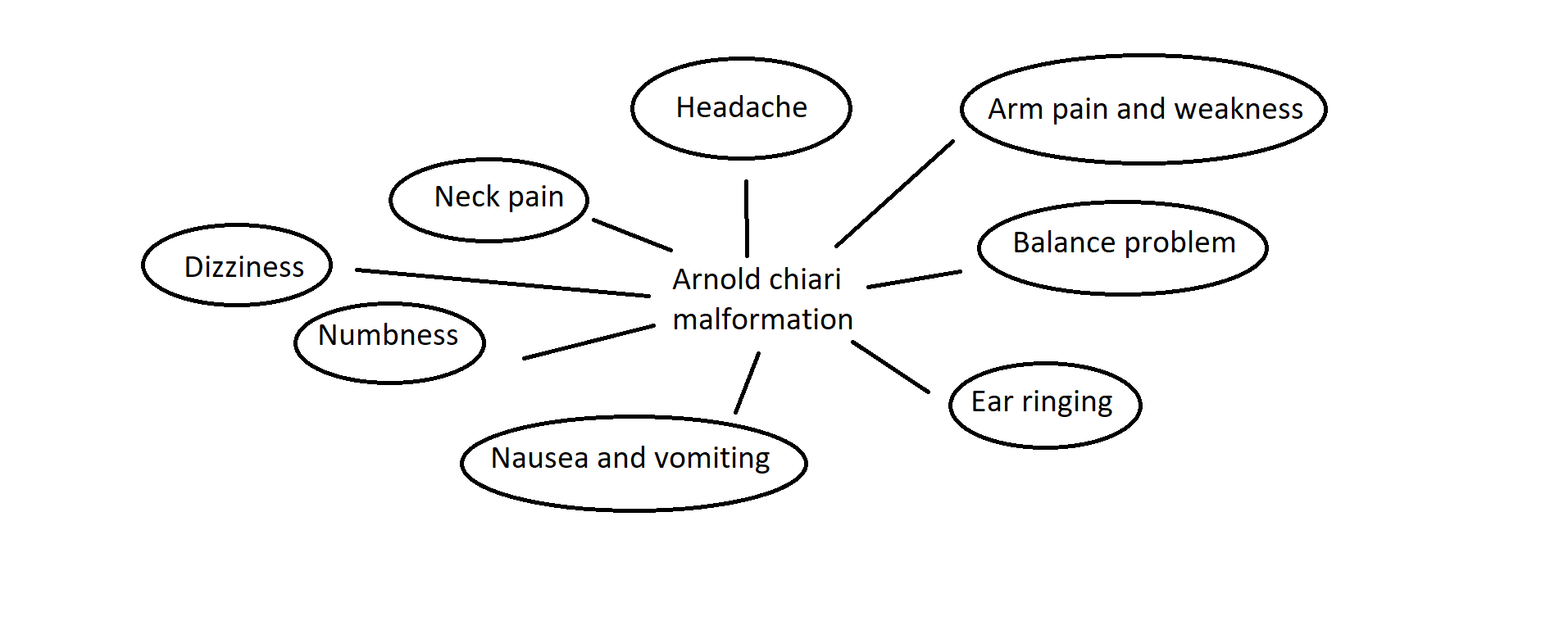Arnold-Chiari malformation history and symptoms
|
Arnold-Chiari malformation Microchapters |
|
Differentiating Arnold-Chiari malformation from other Diseases |
|---|
|
Diagnosis |
|
Treatment |
|
Case Studies |
|
Arnold-Chiari malformation history and symptoms On the Web |
|
American Roentgen Ray Society Images of Arnold-Chiari malformation history and symptoms |
|
Risk calculators and risk factors for Arnold-Chiari malformation history and symptoms |
Editor-In-Chief: C. Michael Gibson, M.S., M.D. [1] Associate Editor(s)-in-Chief: Fahimeh Shojaei, M.D.
Overview
Patients with Arnold-Chiari malformation may have a positive history of lumbar puncture, lumbar-peritoneal shunt, hydrocephalus, syringomyelias,Tethered spinal cord syndrome, neurofibromatosis type 1, Noonan syndrome, Pierre Robin sequence, Klippel-Feil syndrome, Albright hereditary osteodystrophy, x-linked aqueductal stenosis, Goldenhar syndrome, Williams syndrome, Shprintzen- goldberg syndrome, achondroplasia, familial osteosclerosis, velocardiofacial syndrome, and connective tissue disorders. The most common symptoms of Arnold-Chiari malformation is headache, arm pain and weakness, neck pain, nausea and vomiting, balance problem, dizziness and ear ringing.
History and Symptoms
History
Patients with Arnold-Chiari malformation may have a positive history of: [1][2][3][4][5][6]
- Female gender
- Lumbar puncture
- Lumbar-peritoneal shunt
- Connective tissue disorder
- Hydrocephalus
- Syringomyelias
- Syndromes such as:
- Tethered spinal cord syndrome
- Neurofibromatosis type 1
- Noonan syndrome
- Pierre Robin sequence
- Klippel-Feil syndrome
- Albright hereditary osteodystrophy
- X-linked aqueductal stenosis
- Goldenhar syndrome
- Williams syndrome
- Shprintzen- goldberg syndrome
- Achondroplasia
- Familial osteosclerosis
- Velocardiofacial syndrome
Common Symptoms
- Common symptoms of Arnold-Chiari malformation type 1 and 2 include:[7][8][9]
- In infants
- Stridor
- Swallowing difficulties
- In older children
- Limb weakness
- Dizziness
- Vertigo
- Neuropathic pain
- Pain at the point of tethering
- Visual disturbances
- Difficulty swallowing
- Ringing in the ears
- Sleep apnea
- Impaired fine motor skills
- Muscle weakness
- Palpitations
- Excessive clearing of the throat with no obstructions
- In infants
NOTE: Patients may experience no symptoms or remain asymptomatic until early adulthood at which point they will often experience severe headaches and neck pain.
NOTE: Some patients may go an entire lifetime without having noticeable symptoms. Or, symptoms can be minimal, then turn severe suddenly due to head trauma which alters the condition of the spine, brain, or cerebellar tonsils and begins to cause more difficulties.
- Common symptoms of Arnold-Chiari malformation type 3 and 4 include:
- Respiratory failure in infancy
- Seizure (epilepsy)
- Mental retardation
- Flaccid or spastic paralysis
- Sever neurological problems

Source: Fahimeh Shojaei, M.D.
Less Common Symptoms
Less common symptoms of Arnold-Chiari malformation include:
References
- ↑ "Neuropathology For Medical Students".
- ↑ Milhorat TH, Bolognese PA, Nishikawa M, McDonnell NB, Francomano CA (2007). "Syndrome of occipitoatlantoaxial hypermobility, cranial settling, and chiari malformation type I in patients with hereditary disorders of connective tissue". Journal of Neurosurgery: Spine. 7 (6): 601–9. doi:10.3171/SPI-07/12/601. PMID 18074684. Unknown parameter
|month=ignored (help) - ↑ Holder-Espinasse M, Abadie V, Cormier-Daire V, Beyler C, Manach Y, Munnich A, Lyonnet S, Couly G, Amiel J (October 2001). "Pierre Robin sequence: a series of 117 consecutive cases". J. Pediatr. 139 (4): 588–90. doi:10.1067/mpd.2001.117784. PMID 11598609.
- ↑ Tubbs RS, Rutledge SL, Kosentka A, Bartolucci AA, Oakes WJ (April 2004). "Chiari I malformation and neurofibromatosis type 1". Pediatr. Neurol. 30 (4): 278–80. doi:10.1016/j.pediatrneurol.2003.09.013. PMID 15087107.
- ↑ Schanker, Benjamin D.; Walcott, Brian P.; Nahed, Brian V.; Kahle, Kristopher T.; Li, Yan Michael; Coumans, Jean-Valery C. E. (2011). "Familial Chiari malformation: case series". Neurosurgical Focus. 31 (3): E1. doi:10.3171/2011.6.FOCUS11104. ISSN 1092-0684.
- ↑ Holder-Espinasse M, Winter RM (October 2003). "Type 1 Arnold-Chiari malformation and Noonan syndrome. A new diagnostic feature?". Clin. Dysmorphol. 12 (4): 275. doi:10.1097/01.mcd.0000081505.97834.0a. PMID 14564218.
- ↑ Dyste, Gregg N.; Menezes, Arnold H.; VanGilder, John C. (1989). "Symptomatic Chiari malformations". Journal of Neurosurgery. 71 (2): 159–168. doi:10.3171/jns.1989.71.2.0159. ISSN 0022-3085.
- ↑ Bell, William O.; Charney, Edward B.; Bruce, Derek A.; Sutton, Leslie N.; Schut, Luis (1987). "Symptomatic Arnold-Chiari malformation: review of experience with 22 cases". Journal of Neurosurgery. 66 (6): 812–816. doi:10.3171/jns.1987.66.6.0812. ISSN 0022-3085.
- ↑ Papasozomenos, S.; Roessmann, U. (1981). "Respiratory distress and Arnold-Chiari malformation". Neurology. 31 (1): 97–97. doi:10.1212/WNL.31.1.97. ISSN 0028-3878.